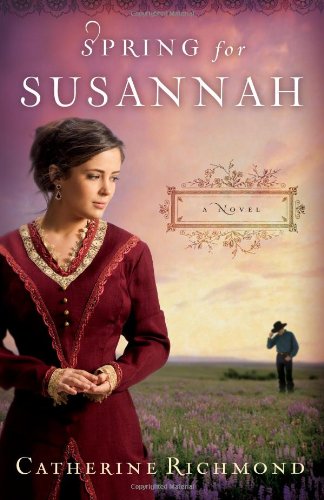 Synopsis:
Synopsis:
Susannah Underhill has always been painfully shy and socially inept. She considers herself plain. She grew up in Detroit, the only child of a veterinary surgeon, in a household devoid of displays of affection or recognition of emotions. Susannah devoted herself to caring for her mother during her final illness and with both of her parents deceased, Susannah was taken in by her pastor and his wife.
The pastor’s older brother, Jesse, is a Dakota Territory homesteader with a desire to marry and start a family. The pastor and his wife believe Susannah will be a good match for Jesse. With no other prospects, Susannah reluctantly agrees to become a mail-order bride after corresponding for a period of time with Jesse. After she and Jesse are married by proxy, she boards a train in Detroit bound for her new home on the prairie.
Susannah is not prepared for any aspect of her new life and circumstances. In 1873, Dakota Territory was vast and unsettled, the winters brutally cold and the summers scorchingly hot. When Jesse meets her at the train depot, she is unsure of herself around him and, worse, completely shocked by the seemingly endless expanse of the flat prairie. Jesse’s sod hut is but one room, and seems dark, damp, and confining. Susannah is certain that she has made a terrible mistake by agreeing to the marriage, but with no suitors back home in Detroit and no dowry to offer another man, she determines to honor the vow she made to Jesse.
Having grown up in a family of ten children, Jesse is demonstrative, loving, and incredibly patient with his new bride. He is determined to turn his homestead into a successful working farm and live up to his promise to care for Susannah and keep her safe. Jesse is a Civil War veteran, however, suffering from periodic flashbacks that frighten Susannah; she is battling a few demons of her own.
Together they set about creating a home and family on the prairie. But will they survive the harsh winters and other challenges that come their way? Will they learn to trust and truly love each other?
Review:

Poor Susannah has absolutely no idea what to expect when she leaves Detroit. She is unprepared for marriage, especially to a man with a big heart and eagerness to be her partner in every sense of the word. While she believes that her place is simply to defer to her husband, letting him make the decisions and give her directions, Jesse wants her to talk to him about her life, feelings, opinions, and dreams. Jesse has survived a couple of brutally long prairie winters with only his dog, Jake, to keep him company. He craves companionship and affection, while Susannah was taught to subvert her own feelings and desires. Her mother told her it was impolite for a woman to talk about herself. Jesse’s patience is tested, but he is tenaciously determined to cherish and care for the woman he believes is a flesh-and-blood answer to his prayers. Susannah recognizes that she is developing genuine feelings of affection and desire for Jesse. Will they or won’t they fall in love and turn their marriage by proxy into a real union? Readers will keep turning the pages in an effort to find out.
Dakota Territory has many unwelcome surprises for Susannah, and she must learn — often, the hard way — how to live miles from the nearest other homesteaders in rudimentary conditions, only venturing to the nearest actual town for supplies a couple of times per year. The isolation, drastic weather conditions, and constant effort to merely survive threaten to send Susannah back to Detroit on the next available train, but she is equally stubborn and wants to honor her commitment to Jesse and the marriage. Richmond’s descriptions of the couple’s trials are authentic and appropriately harrowing. When she heartbreakingly miscarries their first child, nearly bleeding to death, both she and Jesse are devastated, but in the aftermath of that tragedy, Susannah’s devotion to Jesse grows deeper when she realizes that he literally saved her life and cared for her for weeks while she recuperated.
Richmond injects humor and a sense of joy into an otherwise serious tale. Susannah learns to be playful with Jesse by watching Ivar and Marta’s ease with each other. Never having been teased before, she eventually learns to take Jesse’s loving banter in stride, and even give back a little. Susannah also grows in confidence and self-assurance as she finds strength she never knew she possessed. She learned much assisting her veterinarian father and her skills are invaluable. With Jesse’s encouragement, she gradually realizes her own self-worth and resilience.
Spring for Susannah is engrossing and exciting. Richmond’s writing style is crisp and her pacing perfection, her descriptions of the prairie so vivid that you will practically feel the winter ripping across the Prairie and smell the bacon frying in the pan in Susannah and Jesse’s little sod home. Susannah and Jesse are likable and endearing — readers will want them to have a happily-ever-after. In all, Spring for Susannah is an impressive first novel that will give Richmond’s readers a new appreciation of what our ancestors endured as they struggled to establish homes and communities in the vast expanse that would one day become North and South Dakota.



4 Comments
Janie, Applause to your great-grandparents for surviving! We camped in North Dakota, mostly around Valley City where Spring for Susannah is set. I’m from the DC area where camping means squeezing into a tiny park, hearing the guy in the next tent sneeze, hearing several baseball games on the radio. How wonderful to camp in North Dakota where we shared the park with deer and thirteen-line ground squirrels, and could see the Milky Way once the sun eventually set. Thanks so much for your wonderful review! Blessings!
Catherine:
My uncle was the Asst. Chief of Police in Valley City, so I’ve been there! I was born in Britton, S.D. and used to visit during the summer as a child. It is only 6 miles from the No. Dakota border, about 60 miles from Aberdeen. My mother grew up on the family homestead and went to school in Kidder, a little town that no longer exists. We were all baptized and my parents were married in the Pleasant Valley Lutheran Church which, in those days, was the Norwegian congregation. My mother always referred to the Lutheran church in Britton as the “English Lutheran Church.” As for my father, he grew up in Newark, South Dakota, another little town that hasn’t existed for decades. I grew up in a household where “Uffda!” was a common expression and my parents made lefse at Christmastime, along with sunbakkels and other treats. No lutefisk, though. I pass on that stuff, but have memories of my Norwegian grandmother eating the leftovers out of the bowl — cold. (Gross!)
I loved the book and hope you continue writing because you are very talented! I love stories about how our ancestors survived on the prairie. Your descriptions made it come alive and were, I’m sure, invaluable for folks who have never seen how vast, empty and desolate the prairie can be. For those of us who have seen it — the 20th or 21st century version, at least — your writing enhanced the memories. Great job!
What a terrific review…and it sounds like a great book!
My review this week is also of an historical fiction book. Hope you’ll stop by and say hello!
Janie, When we visited ND, I tried lefse. But lutefisk… your grandma must have been extremely frugal to have eaten it cold!